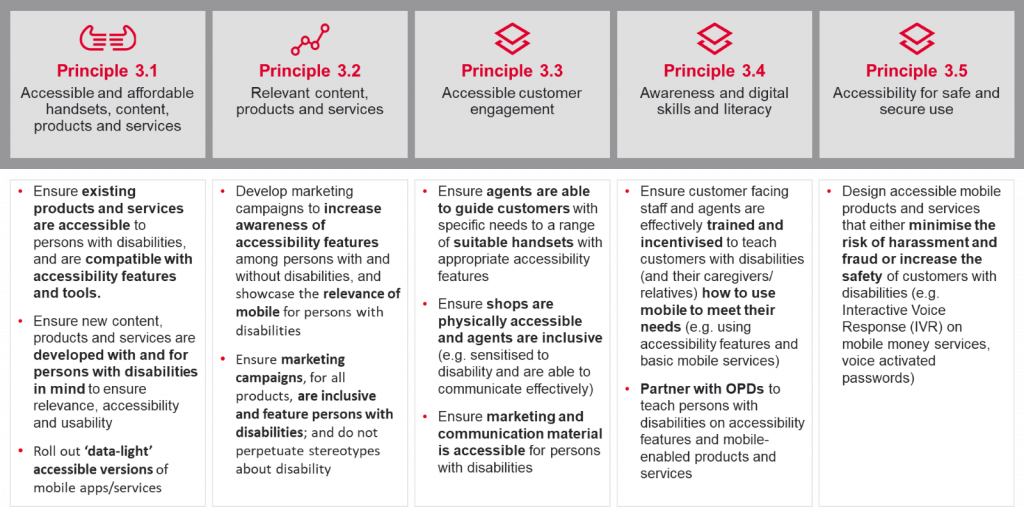Having worked on the Assistive Tech Programme for almost two years, it’s become habit to notice accessibility and inaccessibility all around me. A few days ago I was staring at the braille on my daughter’s medication packaging and it suddenly occurred to me that at some stage the powers that be decided that some things needed to be accessible – physical currency, medication packaging, some text books… the list isn’t very long. I wondered why we stopped there and why medication packaging is accessible, but cereal boxes aren’t. It’s clear that making everything accessible using traditional methods is prohibitively expensive and almost impossible to mandate everyone to do. But really, cereal boxes should be accessible. Everything should be accessible. To everyone.
The good thing is that this digital world that we live in presents an opportunity to do just that – make everything accessible – in a far more achievable and affordable way. For many, mobile devices are a gateway to the digital world, this is especially true for populations in low- and middle-income countries (LMICs) which represent approximately three quarters of all mobile internet users globally. Mobile devices can also cluster together multiple assistive technologies in a single device, making them incredibly useful tools for persons with disabilities. Some innovative mobile-enabled assistive technologies actually do help people with disabilities identify the cereal of their choice and process information on the packaging.
But what if this gateway itself is inaccessible? Then, instead of digital inclusion, you have the current state of play, where persons with disabilities are largely excluded. For this reason, ensuring digital accessibility is a crucial step towards digital inclusion.
What is digital accessibility?
Digital accessibility is recognised as a key priority in several global commitments, including the Convention on the Rights of Persons with Disabilities (CRPD), the Sustainable Development Goals (SDG) and the UN Disability Inclusion Strategy, with the core aim to ensure “no one is left behind” in our increasingly digital world. According to AbilityNet, accessibility is about universality and making something that can be used by as many people as possible. So, digital accessibility is about ensuring that all digital products and services can be used by everyone, including persons with disabilities.
While there has been progress on improving digital accessibility, the digital world still remains mostly exclusive for persons with disabilities due to prevailing barriers. These barriers make digital products and services unattainable, difficult or even impossible to use for some persons with disabilities. GSMA research insights suggest that in LMICs specifically, these barriers are even more disabling.
First things first…
Before we consider the accessibility of digital products and services, the challenges faced by persons with disabilities w.r.t. accessing or owning mobile devices need to be addressed. In some LMICs, the mobile ownership disability gap is as high as 47 per cent in Bangladesh, and 44 per cent in Nigeria. Smartphones present a far more useful tool for persons with disabilities due to embedded accessibility features, but the smartphone ownership disability gaps are even higher – 73 per cent in Bangladesh and 80 per cent in Nigeria. The barriers for mobile ownership by persons with disabilities vary for different markets, but low levels of literacy and skills, affordability of mobile devices and the perceived irrelevance of mobile for persons with disabilities are some of the main barriers identified in GSMA research. For more on this, please read the related report blog.
The mobile industry’s role in improving digital accessibility
Let’s assume we as an industry are able to reduce the mobile disability gap in phone ownership, then what, job done? Unfortunately, we’d only just be scratching the surface of the problem. Even if equitable mobile ownership was ensured for persons with disabilities, the challenge of inaccessibility of devices and mobile-enabled products and services would still need to be addressed.
Historically, ensuring digital accessibility has resulted in good business for mobile operators:
‘In the 1980s, Finnish engineer Matti Makkonen wanted to create a system that would help hearing-impaired people communicate on mobile networks. Makkonen pitched the concept in 1984, and the first SMS message — “Merry Christmas” — was sent in 1992. Today, texts are a part of our everyday lives. An estimated 3.5 trillion text messages were sent around the world in 2020.’ (rest of world)
Designing mobile products and services to meet the needs of persons with disabilities has, and will continue to drive significant technological advancements and business growth. Around 15 per cent of the world’s population, or estimated one billion people, live with disabilities, 80 per cent of whom live in LMICs. According to the WHO they are the world’s largest minority, representing a large underserved and untapped customer segment for mobile operators. Our research also shows that when the accessibility barriers are removed, customers with disabilities are equal consumers of mobile services as non-disabled customers, and in some cases, even power-users.
Despite the progress made by our industry, mobile operators can and must make great strides in ensuring accessibility of all their products and services for persons with disabilities. On International Day of Persons with Disabilities 2020, the GSMA Assistive Tech Programme launched the Principles for the Digital Inclusion of People with Disabilities, which provides mobile operators with a holistic framework for action. The GSMA, and other reputable disability experts believe these actions will reduce the gap in access and usage of mobile-enabled products and services by persons with disabilities. Below I’ve shared an extract of the Principles recommendations pertaining to accessibility specifically, but the full set of recommendations are available on the Principles website.

Our research also suggests that a lack of awareness of mobile accessibility features and mobile internet are key barriers to experiencing the full benefits of mobile for people with disabilities – Quick survey: do you know how to access and use your phones accessibility features? The mobile industry is well positioned and has a key role to play in driving improved digital skills among persons with disabilities to ensure they have unrestricted use of, and benefits from mobile. In response to this, the GSMA has developed the Mobile Internet Skills Training Toolkit (MISTT), which provides a set of free resources (available in PDF and video format) to teach people the basic skills they need to access and use mobile devices. It includes a module on how to use accessibility features as well as modules on using mobile-enabled services such as the internet and other popular applications. In addition to the MISTT resources, the GSMA provides implementation partners with guidance on best practice for rolling out MISTT as well as monitoring impact on beneficiaries. For more information on this, please reach out to [email protected].
Webinar – Driving the digital inclusion of persons with disabilities in APAC: Progress and Opportunities.
Marking the tenth anniversary of Global Accessibility Awareness Day (GAAD), the GSMA and Facebook APAC hosted a webinar on Driving the digital inclusion of persons with disabilities in APAC: Progress and Opportunities. The session included a presentation on GSMA research insights from the APAC region, the latest advancements on accessibility at Facebook and an honest and inspiring discussion with some incredibly passionate and experienced panellists. The webinar presentation deck and recording is available to access and view.


